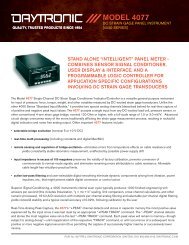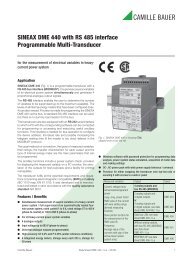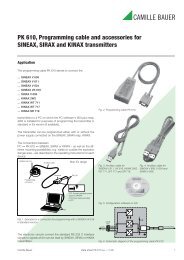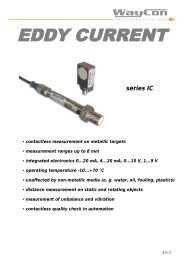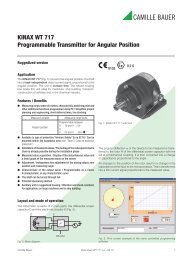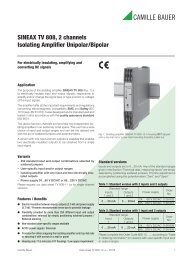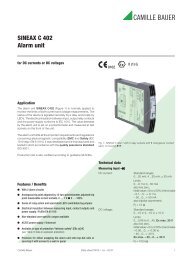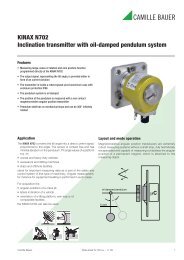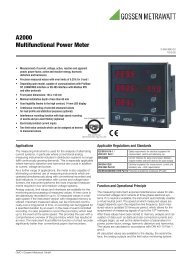SINEAX 2I1 Passive DC Signal Isolator - Camille Bauer AG
SINEAX 2I1 Passive DC Signal Isolator - Camille Bauer AG
SINEAX 2I1 Passive DC Signal Isolator - Camille Bauer AG
You also want an ePaper? Increase the reach of your titles
YUMPU automatically turns print PDFs into web optimized ePapers that Google loves.
<strong>SINEAX</strong> <strong>2I1</strong><strong>Passive</strong> <strong>DC</strong> <strong>Signal</strong> <strong>Isolator</strong>without power supply0102II (1) G resp. II (2) GApplicationThe <strong>DC</strong> signal isolator <strong>SINEAX</strong> <strong>2I1</strong> (Fig. 1) serve to isolate loadindependent<strong>DC</strong> current signals. It suppressed noise voltagesand currents in a signal loop circuit.Features / Benefits● Electrically insulated between input and output / Prevents the transferof interference voltages and currents, overcomes signal connectionproblems● Input signal : Output signal = 1 : 1● No power supply required / No additional wiring and no power supplyunit● Immune to transient voltages● Single-channel● Available in type of protection “Intrinsic safety” [EEx ib] IIC(see “Table 2: Data on explosion protection”)Fig. 1. <strong>SINEAX</strong> <strong>2I1</strong> in housing N for rail or wall mounting.Layout and mode of operationThe <strong>DC</strong> signal isolator comprises a <strong>DC</strong> chopper Z, an isolatingstage T, a rectifi er G and a multivibrator M (see Fig. 2). The <strong>DC</strong>chopper converts the load independent <strong>DC</strong> signal into an ACsignal. This signal is passed through a ferrite-core transformerserving as an isolating stage. On the secondary side, it is rectifi ed,smoothed and converted into a load-independent <strong>DC</strong> signal.The chopper unit is controlled by a specially designed multivibratorwhich obtains its power from the input signal.I EU EZMT G I AU VU A R extTechnical dataGeneralMTBF:Input signal EInput current (I E):Max. input voltage:Permissible input ripple: ≤ 10%Voltage loss U Vacrosssignal isolator:Approx. 120 000 h per isolatorLoad-independent <strong>DC</strong> current0 to 5 mA to 0 to 20 mA,4 to 20 mA(all ranges are possible with the sametype)U E≤ 15 V (see “Application example,Fig. 10, page 4)– non-intrinsically safe versionapprox. 3 V– intrinsically safe versionapprox. 6 VFig. 2. Schematic diagram.Overload capacity:≤ 50 mA continuous<strong>Camille</strong> <strong>Bauer</strong> Data sheet 84-<strong>2I1</strong> Le – 07.07 1
<strong>SINEAX</strong> <strong>2I1</strong><strong>Passive</strong> <strong>DC</strong> <strong>Signal</strong> <strong>Isolator</strong>Output signal AOutput signal (I A):Transformation ratio: 1 : 1Residual ripple inoutput current:Time constant:Load-independent <strong>DC</strong> current≤ 0.5% (7 kHz)Approx. 100 msMounting position:Electrical connections:Weight:RegulationsAnyScrew terminals with indirect wirepressure, suitable formax. 2 ×1.5 mm 2 or 1×2.5 mm 2Approx. 100 gOutput load voltage: U A= U E– U V(Fig. 2)Accuracy dataReference value:20 mADeviation from specifiedcharacteristic underreference conditions: Max. ± 0.1%Reference conditions:Ambient temperatureInput current I EExternal load R ext23 °C ± 1 K0 to 20 mA250 ΩElectromagneticcompatibility:The standards DIN EN 50 081-2 andDIN EN 50 082-2 are observedIntrinsically safe: Acc. to EN 50 020: 1994Max. surge voltage:5 kV, 1.2/50 µs surge withstand testIEC 255.4 and Surge withstand test,as per IEEE-Std. 472-1975.Common-mode and differentialmodebetween any two terminalsElectrical design: Acc. to EN 61 010Protection: Housing IP 40 acc. to EN 60 529Terminals IP 20Additional error:Test voltage:4 kV, 50 Hz, 1 min.Dependence onoutput loadTemperature influenceInstallation dataMechanical design:Mounting versions:< + 0.1% / 100 Ω if R ext< 250 Ω< – 0.1% / 100 Ω if R ext> 250 Ω< 0.1% / 10 Kfor + 10 ≤ t ≤ + 40 °C< 0.2% / 10 Kfor – 25 ≤ t ≤ + 10 °C andfor + 40 ≤ t ≤ + 55 °CHousing type N in plastic for railor wall mounting. (Dimensions seeSection “Dimensional drawings”)For snap mounting on G-type rail orcap-type rail (see Section “Dimensionaldrawings”)Environmental conditionsOperating temperature: – 25 to + 55 °Cfor standard version– 20 to + 40 °Cfor Ex versionsStorage temperature: – 40 to + 70 °CRelative humidityof annual mean:Altitude:Indoor use only!≤ 75% standard climatic rating≤ 90% improved climatic rating2000 m max.Table 1: Type overviewDescription Type Article NumberStandard version 84-<strong>2I1</strong>-10 154 253Improved climatic rating 84-<strong>2I1</strong>-10 154 261Intrinsically safe input 84-<strong>2I1</strong>-11 154 279Intrinsically safe output 84-<strong>2I1</strong>-12 154 2872 Data sheet 84-<strong>2I1</strong> Le – 07.07 <strong>Camille</strong> <strong>Bauer</strong>
<strong>SINEAX</strong> <strong>2I1</strong><strong>Passive</strong> <strong>DC</strong> <strong>Signal</strong> <strong>Isolator</strong>Table 2: Data on explosion protectionII (2) G resp. II (1) GTypeArticleNumberType ofprotectionElectrical data acc. to CertificatesInputOutputType examinationcertificateMountinglocation84-<strong>2I1</strong>-11 154 279 [EEx ib] IIC84-<strong>2I1</strong>-12 154 287 [EEx ia] IICL i= 0C i= 0for connection to certifiedintrinsically safe circuit withfollowing maximum values:U i= 30 VI i= 100 mAU m= 253 V ACresp.125 V <strong>DC</strong>U m= 253 V ACresp.125 V <strong>DC</strong>U o= 12,6 VI o= 100 mAP o= 315 mWlinear characteristicIIC IIBL o4 mH 15 mHPTB 98 ATEX 2176OutsidethehazardousareaC o1.15 µF 7.4 µFElectrical connectionsTerminals 3, 4 blueA1– +A1– +A1– +3 43 43 484-<strong>2I1</strong>-1084-<strong>2I1</strong>-1184-<strong>2I1</strong>-12E1 = Input signalA1 = Output signal121212– +E1– +E1– +E1Fig. 3.Type 84-<strong>2I1</strong>-10standard version (non-I.S.).Terminals 1, 2 blueFig. 4.Type 84-<strong>2I1</strong>-11Intrinsically safe input.Fig. 5.Type 84-<strong>2I1</strong>-12Intrinsically safe output.<strong>Camille</strong> <strong>Bauer</strong> Data sheet 84-<strong>2I1</strong> Le – 07.07 3
<strong>SINEAX</strong> <strong>2I1</strong><strong>Passive</strong> <strong>DC</strong> <strong>Signal</strong> <strong>Isolator</strong>Dimensional drawings9585 +0.12.54.624577469.569Fig. 6. <strong>SINEAX</strong> <strong>2I1</strong>for wall mounting.Fig. 7. <strong>SINEAX</strong> <strong>2I1</strong>for mounting on G-type rail,EN 50 035 – G32.Fig. 8. <strong>SINEAX</strong> <strong>2I1</strong>for mounting on cap-typerail, EN 50 022-35 × 7.5.Fig. 9. <strong>SINEAX</strong> <strong>2I1</strong>for mounting on cap-typerail, EN 50 045-15 × 5.5.Application exampleThe output signal generated by the KINAX 3W2 is needed both for local and remote measurement.Problem:Is the burden R2 connected across the output signal of the isolating transformer type 84-<strong>2I1</strong>-10 sufficient for local measurement? Ifnot, then use, for example, <strong>SINEAX</strong> TV 808.2-wiretransducere.g KINAX 3W2XmA4...20 mAU M ≥12 VBurden R1(assumption 50 Ω)24 V U SU E = U S – U MU E = 11 V for R1 = 50 ΩPower packe.g. <strong>SINEAX</strong> B 811Burden R3≤ 750 Ω0...20 mARemotemeasurement<strong>DC</strong> signalisolator84-<strong>2I1</strong>-10U E ≤15VU V = 3 VPower supplyU A4...20 mALocalmeasurementBurden R2U A= U S– U M– U V– (R1 · 20 mA) = 8 VUA [V]Burden R2 [Ω] == 400 Ω0.02 [A]Fig. 10. Typical circuit with an isolating transformer <strong>SINEAX</strong> 84-<strong>2I1</strong>-10,transmitter KINAX 3W2 for angular measurement and a power supplyunit <strong>SINEAX</strong> B 811.Rely on us.<strong>Camille</strong> <strong>Bauer</strong> <strong>AG</strong>Aargauerstrasse 7CH-5610 Wohlen / SwitzerlandPhone: +41 56 618 21 11Fax: +41 56 618 35 35e-Mail: info@camillebauer.comwww.camillebauer.comSubject to change without notice • Edition 07.07 • Data sheet 84-<strong>2I1</strong> Le



